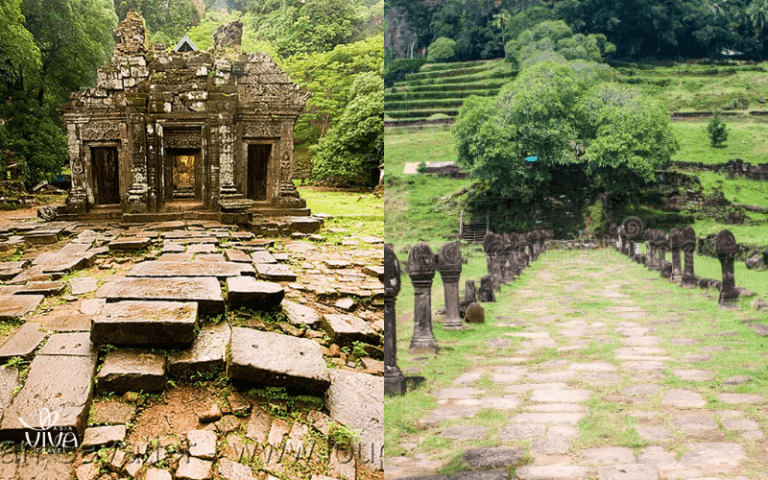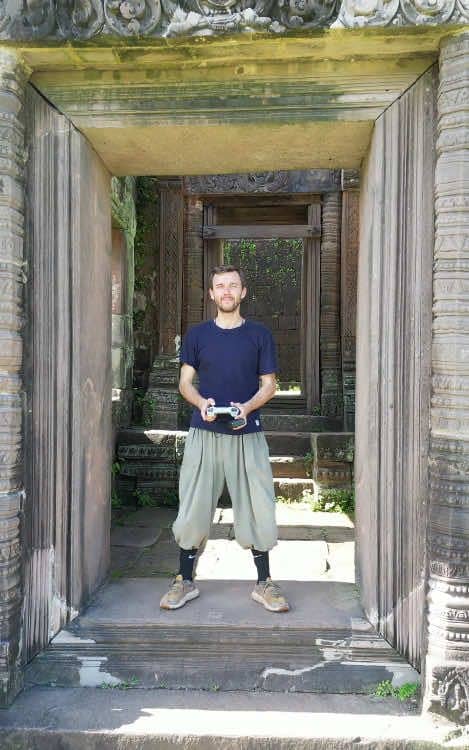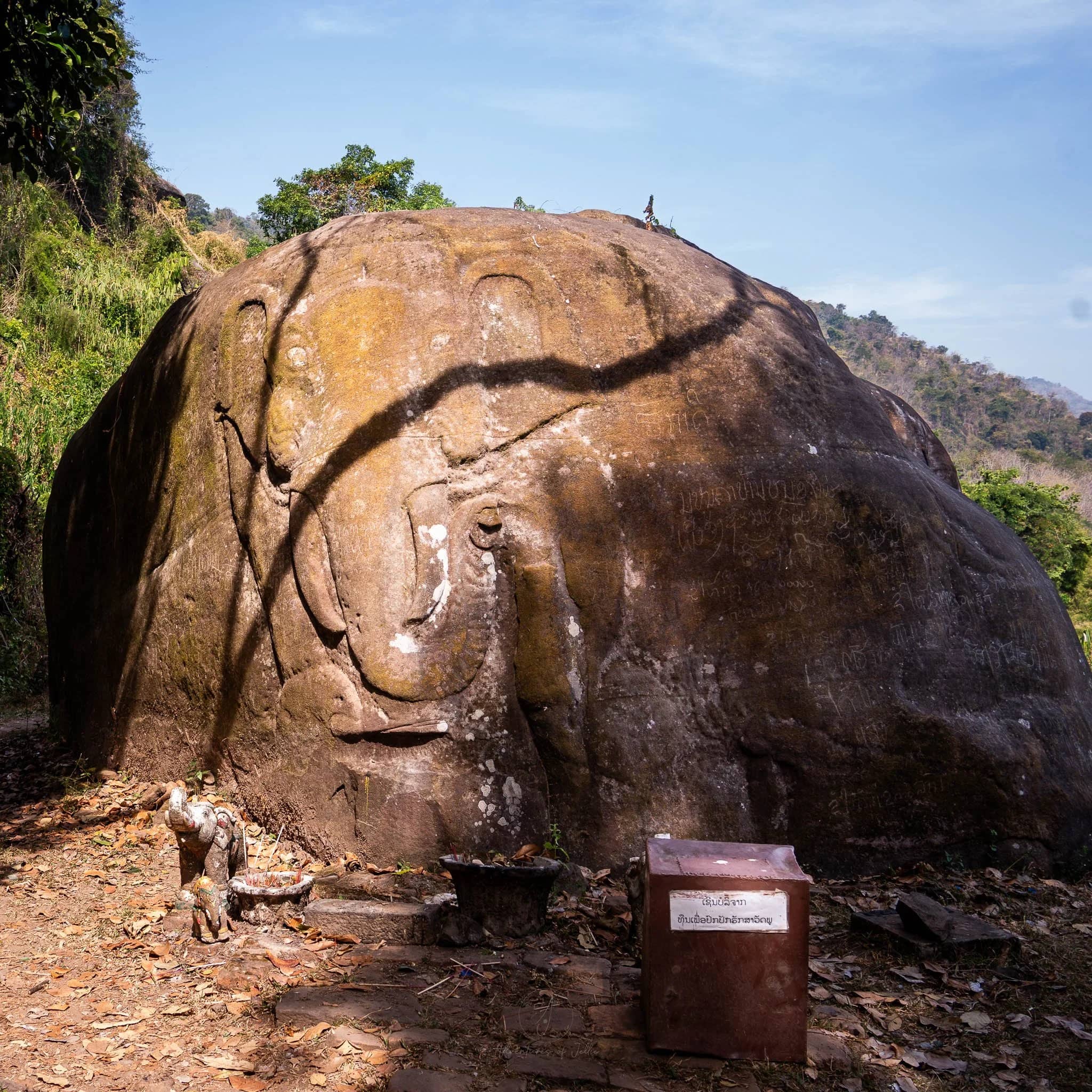Wat Phou
Ancient Khmer temple complex, predating Angkor Wat, offering stunning views and a glimpse into history.

Highlights
Must-see attractions

Social
From TikTok & Reddit
Best Time
Avoids midday heat & crowds
Wat Phou
Best Time
Avoids midday heat & crowds

Highlights
Must-see attractions
Ancient Khmer temple complex, predating Angkor Wat, offering stunning views and a glimpse into history.
"A magnificent ruined Khmer-Hindu temple complex, a UNESCO World Heritage site."
👟 Comfortable Shoes Essential
You'll be doing a lot of walking and climbing. Wear sturdy shoes for exploring the ruins and terraces.
💰 Affordable Entry Fee
The entrance ticket is very cheap, making it a great value for a UNESCO site.
Highlights
Discover the most iconic attractions and experiences
The Upper Terrace Sanctuary
Top level of the complex
Climb to the highest point for breathtaking panoramic views and to explore the main sanctuary.

Processional Pathway
Main entrance to the upper terrace
Walk this ancient path lined with trees and ceremonial ponds, feeling the spiritual ascent.

Lingam-Shaped Rock Formation
Mount Phou Kao summit
See the natural rock formation believed to be a manifestation of Shiva, the site's original deity.
Carved Sandstone Lintels
Lower palaces and sanctuary
Admire the intricate carvings depicting Hindu deities and mythological scenes.
Plans like a pro.
Thinks like you
Planning Your Visit
Beat the Heat and Crowds
Plan Your Visit
Best Times
Insider Tips
from TikTok, Instagram & Reddit
👟 Comfortable Shoes Essential
You'll be doing a lot of walking and climbing. Wear sturdy shoes for exploring the ruins and terraces.
💰 Affordable Entry Fee
The entrance ticket is very cheap, making it a great value for a UNESCO site.
🚗 Golf Cart Option
Use the golf cart service from parking to the site entrance to save energy, especially in heat.
💧 Stay Hydrated
Bring plenty of water, especially if visiting during the hot and dry season.
Tips
from all over the internet
👟 Comfortable Shoes Essential
You'll be doing a lot of walking and climbing. Wear sturdy shoes for exploring the ruins and terraces.
💰 Affordable Entry Fee
The entrance ticket is very cheap, making it a great value for a UNESCO site.
🚗 Golf Cart Option
Use the golf cart service from parking to the site entrance to save energy, especially in heat.
💧 Stay Hydrated
Bring plenty of water, especially if visiting during the hot and dry season.
📸 Capture the Views
The climb to the top offers stunning panoramic views of the surrounding landscape.
What Travellers Say
Reviews Summary
Visitors praise Wat Phou for its beautiful ancient Khmer ruins, affordable entry, and serene atmosphere, often noting its significance as a precursor to Angkor Wat. The stunning views from the upper terraces and the historical depth of the site are frequently highlighted. However, some mention concerns about littering and the upkeep of certain areas.
"Very beautiful ancient sites ,the ticket so cheap and have golf car send us to the place , afternoon is good time to go not so much people"
Ting Oulamek
"I had the beautiful time there.
at Phou (also spelled Wat Phou) is a magnificent ruined Khmer-Hindu temple complex located in the southern part of Laos, in Champasak province. It is a UNESCO World Heritage site and is often referred to as a precursor to the famous temples of Angkor Wat in Cambodia, as it was built by the same civilization centuries earlier.
I'm happy to see the reality of the temple. and the Laos people are friendly."
Seng Pheng
"Vat Phou is a beautiful and significant Khmer temple in Champasak, Laos, renowned for its symbolic design, architectural evolution, and stunning natural setting. A UNESCO World Heritage Site since 2001, it is an outstanding example of the integration of a symbolic landscape with religious beliefs.
Unique Architectural and Symbolic Features 🗿
Vat Phou's beauty lies in its purposeful design, which reflects a Hindu vision of the relationship between nature and humanity. The complex is laid out along a central axis, with its structures stretching over 1.4 kilometers from the Mekong River to the base of Mount Phou Kao.
* Sacred Mountain: The temple is situated at the foot of Mount Phou Kao, which the ancient Khmer believed was a sacred mountain due to a lingam-shaped rock formation on its summit. This natural feature was seen as a manifestation of Shiva, one of the principal deities in Hinduism. The temple's layout was designed to represent the spiritual universe, with the mountain as the home of the gods and the river representing the cosmic ocean.
* Processional Pathway: The complex features a long, processional walkway lined with ancient frangipani trees and ceremonial ponds (barays). This pathway leads visitors on a symbolic ascent, creating a feeling of pilgrimage and spiritual progression as they climb toward the main sanctuary.
* Architectural Evolution: The site showcases the development of Khmer architecture over several centuries, with structures dating from the 7th to the 13th centuries. The main buildings, including the two quadrangular palaces on the lower level and the main sanctuary on the upper terrace, are built from laterite and intricately carved sandstone. The carvings and lintels depict various Hindu deities and mythological scenes, showcasing the exceptional artistry and craftsmanship of the time.
A Fusion of Cultures and Beliefs 🕉️
Originally built as a Hindu temple dedicated to the god Shiva, Vat Phou was later converted into a Buddhist monastery in the 13th century. This transition is evident in the blend of Hindu and Buddhist elements found throughout the complex. While many Hindu carvings and structures remain, the main sanctuary now houses Buddha images and is still an active place of worship for local Buddhists. This cultural fusion adds another layer to its historical and spiritual significance.
Breathtaking Setting and Serenity ✨
Beyond its architectural and historical value, Vat Phou is beautiful because of its tranquil and picturesque setting. The temple's tiered design allows for panoramic views of the surrounding plains and the Mekong River, making the climb to the top a rewarding experience. The ruins, overgrown in parts by ancient trees, evoke a sense of timelessness and connection with nature, which was a core part of its original design. The relative lack of crowds compared to more famous sites like Angkor Wat in Cambodia also contributes to a serene and reflective atmosphere, allowing visitors to fully appreciate its quiet grandeur."
Sy Sovanpanha
What People Like
What People Dislike
Frequently Asked Questions
🚇 🗺️ Getting There
Wat Phou is located in Champasak province, accessible from Pakse. You can hire a taxi or a private car for the approximately 1.5-hour journey. Some travelers opt for a combination of bus and local transport.
While direct public transport might be limited, you can take a bus from Pakse to Champasak town and then arrange local transport or a short taxi ride to the temple complex.
Yes, renting a motorbike in Pakse or Champasak is a popular option for independent travelers, offering flexibility to explore the area at your own pace.
A golf cart service is available from the parking lot to the main temple entrance, which is convenient, especially during hot weather.
Wat Phou is in Laos, while Angkor Wat is in Cambodia. They are both significant Khmer Empire sites but require separate travel between countries.
🎫 🎫 Tickets & Entry
The entrance fee is very affordable, typically around 50,000 LAK (Laotian Kip), making it a great value for a UNESCO World Heritage site.
Wat Phou is generally open daily from morning until late afternoon. It's advisable to check the most current hours upon arrival, but afternoons are recommended to avoid crowds.
Tickets can be purchased on-site at the entrance. Advance booking is usually not necessary for Wat Phou.
Yes, there is a small fee for the golf cart service that takes you from the parking area to the temple complex.
Yes, Wat Phou was inscribed as a UNESCO World Heritage site in 2001, recognizing its outstanding universal value.
🎫 🧭 Onsite Experience
Plan for at least 2-3 hours to explore the entire complex, including the climb to the upper terraces and enjoying the views.
The afternoon is often recommended as it's cooler and there are fewer tour groups, offering a more peaceful experience.
Local guides may be available for hire at the site to provide historical context and insights into the temple's significance.
Dress respectfully, covering your shoulders and knees, as it is a religious site. Comfortable walking shoes are essential.
The lower levels are relatively accessible, but the climb to the upper terraces involves many stairs and uneven terrain, which may be challenging for those with significant mobility issues.
📸 📸 Photography
The panoramic views from the upper terrace are spectacular. Also, capture the intricate carvings, the processional pathway, and the surrounding natural landscape.
While some videos show drone footage, it's always best to check local regulations regarding drone usage at heritage sites to avoid any issues.
Early morning or late afternoon light can be beautiful for photography, offering softer light and fewer harsh shadows.
Photography rules inside active religious sites can vary. Be respectful and check for any signage or ask local attendants before taking photos of religious artifacts.
Generally, photography for personal use is allowed, but commercial photography or filming might require special permits. Always be mindful of other visitors and the sanctity of the site.
For Different Travelers
Tailored advice for your travel style
👨👩👧 Families with Kids
While the climb to the upper terraces involves stairs, the lower levels are more accessible for younger explorers. Pack plenty of water and snacks, and consider visiting in the cooler afternoon hours to ensure everyone stays comfortable. The natural setting also provides opportunities for kids to connect with nature.
🚶 Budget Travelers
Pack your own water and snacks to save on costs within the site. While a golf cart is available, walking the processional pathway is a rewarding experience that doesn't cost extra and allows for a deeper appreciation of the site's design.
📸 Photographers
Capture the details of the sandstone lintels and pillars, the serene atmosphere of the processional pathway, and the panoramic views that stretch across the Mekong River. The site's relative lack of crowds compared to more famous temples can also allow for more unhurried and creative photography.
Deep Dives
In-depth insights and expert knowledge
The History and Significance of Wat Phou
As a UNESCO World Heritage site, Wat Phou is recognized for its outstanding example of integrating a symbolic landscape with religious beliefs. The complex is strategically situated at the foot of Mount Phou Kao, which was considered a sacred mountain by the ancient Khmer. The layout of the temple, stretching over 1.4 kilometers from the Mekong River to the mountain, was designed to represent the spiritual universe, with the mountain as the abode of the gods.
The site showcases the evolution of Khmer architecture, with structures built from laterite and sandstone. The intricate carvings and lintels depict various deities and mythological scenes, highlighting the exceptional artistry of the era. The processional pathway, lined with ancient trees and ceremonial ponds, leads visitors on a symbolic ascent, creating a profound sense of pilgrimage.
Exploring the Sacred Landscape
The journey through Wat Phou is a deliberate one, beginning with a long processional pathway. This pathway is flanked by ancient frangipani trees and features ceremonial ponds, or barays, which were crucial elements in Khmer water management and ritual practices. As visitors ascend, they experience a spiritual progression, moving from the earthly realm towards the divine.
Beyond the architectural marvels, the serene and picturesque setting of Wat Phou contributes significantly to its allure. The tiered design offers breathtaking panoramic views of the surrounding plains and the Mekong River. The ruins, partially reclaimed by nature with ancient trees growing amongst the stones, evoke a timeless connection to the past and the natural world.
Cultural Fusion and Local Life
This blend of traditions adds a rich layer to the site's historical and spiritual significance. Visitors can observe how different beliefs have coexisted and influenced the temple over centuries. The ongoing use of the site by the local community underscores its enduring importance.
The local people in Champasak are known for their friendliness, contributing to a welcoming atmosphere for visitors. While the site is a protected UNESCO area, some reviews mention instances of littering or minor rule-breaking by visitors or locals, highlighting the ongoing challenge of preserving such historical sites.
Social
from TikTok, Instagram & Reddit